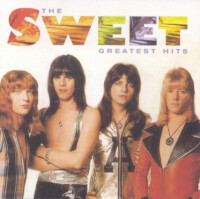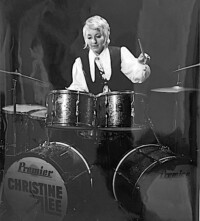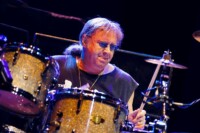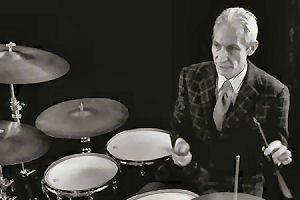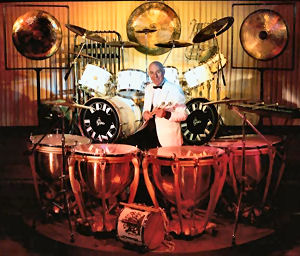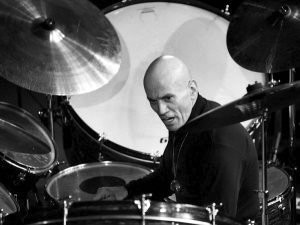 ‘Ed’ Cassidy was born in 1923 and appears in this series on two counts. The first is by virtue of being ‘rock’ music’s oldest drummer, and the second is by being the first person in the sixties to have an exceedingly large drum kit. I’m not sure if anyone’s going to catch him up on the first accolade because he had been a professional drummer for 72 years when he died, and I know that to date I have only managed to be a professional musician for what seems, in the light of Ed’s achievement, to be an insignificant 55 years! The Guinness Book of World Records had Ed Cassidy listed as “The World’s Oldest Performing Rock ‘n’ Roll drummer.
‘Ed’ Cassidy was born in 1923 and appears in this series on two counts. The first is by virtue of being ‘rock’ music’s oldest drummer, and the second is by being the first person in the sixties to have an exceedingly large drum kit. I’m not sure if anyone’s going to catch him up on the first accolade because he had been a professional drummer for 72 years when he died, and I know that to date I have only managed to be a professional musician for what seems, in the light of Ed’s achievement, to be an insignificant 55 years! The Guinness Book of World Records had Ed Cassidy listed as “The World’s Oldest Performing Rock ‘n’ Roll drummer.
Ed was born on May the 4th – generations before there was an ‘Obi Wan Kenobi’, ‘Darth Vader’ or even a ‘Star Wars’! If you know what I mean?
He played for a band called ‘Spirit’ from 1965 to 1997 whose members were recently in the news for threatening to sue Led Zeppelin over alleged plagiarism with the song “Stairway to Heaven” which it is claimed was ripped-off from their song “Taurus”. [As far as I currently know Randy’s son and Spirit’s bass player Mark Andes will drop their law suit for £1 provided Randy California is acknowledged as another co-writer – with all the back royalties accruing to that status, which should be a reasonable amount as the song has to date earned $525 million in royalties and record sales!]
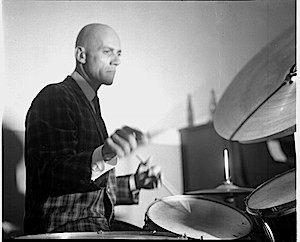 Ed Cassidy was born on a farm in Harvey, Illinois a somewhat impoverished suburb of rural Chicago and his mother said: “He always had the willingness to want to sing, dance and carry on from the time he was able to walk”. He moved with his family to Bakersfield California during the depression when he was six years old whereupon he eventually took up drumming and evidently became a professional drummer in 1937 at a rather impressive 12 years old.
Ed Cassidy was born on a farm in Harvey, Illinois a somewhat impoverished suburb of rural Chicago and his mother said: “He always had the willingness to want to sing, dance and carry on from the time he was able to walk”. He moved with his family to Bakersfield California during the depression when he was six years old whereupon he eventually took up drumming and evidently became a professional drummer in 1937 at a rather impressive 12 years old.
He began his music career by playing with Blues musicians towards the end of the thirties, and then in the forties he switched very slightly to playing jazz with Big Bands. The war came along and like many he was conscripted into the US Navy, although not as a drummer – like several of his contemporaries whom I’ve written about in ‘Groovers and Shakers’ – but as a Stevedore.
Bakersfield is famous for oil, gas and petrol refining so Ed had many associated jobs while he lived there after his demob including: salesman, cab driver, swimming pool service-man, aircraft-mechanic, truck driver and gardener. Eventually he was able to settle down to being a professional drummer. So much so that in the late ‘forties’ he evidently played 282 back-to-back one night stands over 17 states which in those days before air-travel for the masses, must have taken a lot of doing. During this period Ed played various styles of music including: Dixieland, Country & Western, Showband, Polkas, Latin, film soundtracks and even a stint with the San Francisco Opera. In 1950 he decided he wanted to be a music teacher and enrolled in college but a year later he abandoned the idea and instead moved down the coast to Southern California. He wanted to become a proper jazz drummer by meeting and playing with other musicians and with the idea of starting a band of his own.
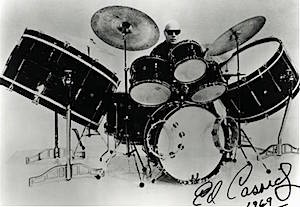 He went on to play with some absolutely seminal jazz musicians including (to name but a few): Cannonball Aderley, Lee Konitz, Thelonius monk, Roland Kirk, Gerry Mulligan, Dexter Gordon, Art Pepper, Chet Baker and Roy Ayers. However, in 1964 he changed direction almost completely and started a band called ‘The Rising Sons’ with Taj Mahal and Ry Cooder. But he left them a year later after injuring his wrist evidently while playing the ‘sons’ version of the Allman Brothers’ favourite – “Statesboro Blues”.
He went on to play with some absolutely seminal jazz musicians including (to name but a few): Cannonball Aderley, Lee Konitz, Thelonius monk, Roland Kirk, Gerry Mulligan, Dexter Gordon, Art Pepper, Chet Baker and Roy Ayers. However, in 1964 he changed direction almost completely and started a band called ‘The Rising Sons’ with Taj Mahal and Ry Cooder. But he left them a year later after injuring his wrist evidently while playing the ‘sons’ version of the Allman Brothers’ favourite – “Statesboro Blues”.
Ed shaved his head, began to dress completely in black and assumed the nickname ‘Mr Skin’ for his next band called ‘The Red Roosters’. He formed this band with (among others) his stepson Randy California (née Randy Wolfe) and Jay Fergusson. Three years later this band morphed into a 5-piece initially called ‘Spirits Rebellious’ when Ed Cassidy teamed up again with Randy who was a contemporary of Jimi Hendrix, and who gave him the surname California. Eventually the band’s name was shortened to Spirit. Ed Cassidy was more than twice the age of the others in the band and this became a huge talking point, particularly in the in-depth magazine articles of the time. He defended himself in Modern Drummer with: “You have to keep the child alive in you. It only matters that you feel good about yourself. The age thing only matters to someone else!”.
Spirit effectively ended when Randy California sadly drowned while attempting to rescue his young son Quinn who was caught in a riptide in Hawaii in 1997. Previous members Jay Ferguson and Mark Andes had both left in 1970 to find further fame with Jo Jo Gunne of “Run, Run, Run” fame.
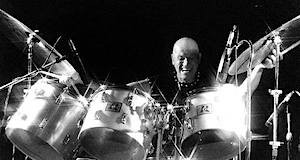 As I said, the band’s name was shortened to Spirit and in their day they were a very successful musical entity and made several well-received records the biggest being a hit single called “I Got A Line On You”. This was along with something like 15 albums including: “Twelve Dreams Of Dr. Sardonicus”, “The Family That Plays Together”, “Clear” and “Fresh Garbage”.
As I said, the band’s name was shortened to Spirit and in their day they were a very successful musical entity and made several well-received records the biggest being a hit single called “I Got A Line On You”. This was along with something like 15 albums including: “Twelve Dreams Of Dr. Sardonicus”, “The Family That Plays Together”, “Clear” and “Fresh Garbage”.
Spirit’s music was described initially as being “psychedelic jazz influenced” and Ed was quoted in ‘The LA Times’ saying: “Rock ‘n’ roll music really saved my bacon musically. What I wanted was a band with no categories that could attempt anything, any style and make it their own”.
The transition from the dotted rhythms of jazz to the often relentlessly straight eights of rock has frequently proved to be a stumbling block for dyed-in-the-wool jazz drummers and Ed Cassidy (who originally played jazz with a traditional grip) admitted he was no exception. “It took a while to get that straight rock beat down. I only found the transition difficult when I first got into hard playing. There was such a dramatic change from jazz to playing hard – and playing different. ”
 An article by John d’Agostino in Rodeo magazine critiquing the first album he said: “Ed played drums in a reserved manner that seemed neither rock- nor jazz- derived, but instead had the characteristics of incidental percussion.”
An article by John d’Agostino in Rodeo magazine critiquing the first album he said: “Ed played drums in a reserved manner that seemed neither rock- nor jazz- derived, but instead had the characteristics of incidental percussion.”
I played on shows with Spirit in the seventies although, as was frequently the nature of these things, I didn’t actually meet Ed Cassidy. But to me he had successfully straightened those eights and to me sounded to be a no-nonsense rock drummer with an insistent offbeat – very much like Buddy Miles in ‘Band of Gypsy’s’. I found an article where he said: “You’re never too old to rock ‘n’ roll. [It] started out basically for young people and just caught on. It was one of the best things to happen [and] gave musicians more freedom than jazz or classical.”
Spirit stopped playing on Randy’s death in 1997, where after Ed hosted drum clinics, carried on with gigs and lectured wryly and knowledgeably at the University of Denver on “The Perils of the Music Business”. He also took up acting running live improv. classes and had roles in films and a long-running daily Soap Opera on American TV called ‘General Hospital’.
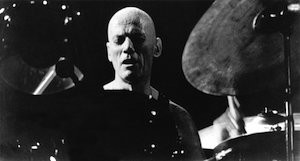 As I said in the first paragraph Ed had a very large drum set at the beginning of his rock career but in his jazz days of course he played at best a regular 4-drum set-up. I managed to turn up a photo of him with what seems to be a Slingerland ‘Radio-King’ set with straight ‘stick-chopper’, single-flange hoops, cast claws on the floor tom and a couple of what appear to be 20 or 22” Zildjian cymbals and 14” hi hats.
As I said in the first paragraph Ed had a very large drum set at the beginning of his rock career but in his jazz days of course he played at best a regular 4-drum set-up. I managed to turn up a photo of him with what seems to be a Slingerland ‘Radio-King’ set with straight ‘stick-chopper’, single-flange hoops, cast claws on the floor tom and a couple of what appear to be 20 or 22” Zildjian cymbals and 14” hi hats.
As far as his-late sixties drums are concerned he started something which few (if any) other drummers have taken up – orchestral bass drums angled to left and right of the player. The oldest Spirit-era photo from 1969 shows him with a black, double-headed Chicago-era Ludwig set although I can’t find any evidence of him having been an endorser. Although with a set that size (unless he was of independent means) you’d have to assume he probably was helped by Ludwig. He had what I’m guessing were 13”, 14” and 15” mounted toms, and 16 x 16” and 18 x 16” floor toms. Those Ludwig orchestral bass drums were available in sizes ranging from 28 x 14” up to 40 x 18” but again I’m afraid I can’t tell you exactly which of these Ed had although I saw a post on the web which said they were 36” in diameter.
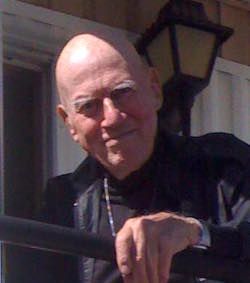 There were a couple more almost identical Ludwig kits, one of which was a psychedelic red single-headed one as well as a post 1976 Rogers ‘Big R’ single-headed set in silver with Memrilok stands and the bottom heads removed. He still had the same orchestral basses to left and right which must have had to be custom-built since I can’t find any evidence of them existing in any catalogue. I did manage to find a photo of Ed with w
There were a couple more almost identical Ludwig kits, one of which was a psychedelic red single-headed one as well as a post 1976 Rogers ‘Big R’ single-headed set in silver with Memrilok stands and the bottom heads removed. He still had the same orchestral basses to left and right which must have had to be custom-built since I can’t find any evidence of them existing in any catalogue. I did manage to find a photo of Ed with w
hat appears to be a large Yamaha kit but I can’t give you any more information about that. I’m guessing his cymbals all the way through his career were courtesy of Zildjian.
Jazz was always Ed’s love and towards the end he was a Disc Jockey for a low-watt radio station in Grover Beach, north of LA, where he played all his favourite artists and tunes.
Ed Cassidy died from cancer aged 89 in San Jose on December 6th 2012. One of his pals rightly said of him towards the end of his life: “the fact that Ed could still play [rock] drums into his eighties is amazing!”.
Bob Henrit
June 2016

